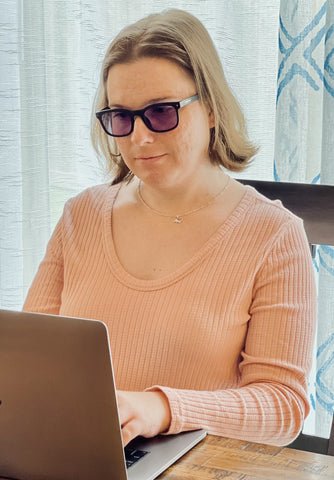A 2021 study shed light on the distinctive hurdles faced by colour blind women. The groundbreaking survey delves into the often overlooked and unique challenges encountered by women with Colour Vision Deficiency (CVD), more commonly known as “colour blindness,” a condition that is notably rare among females, affecting only one in 200 (0.5%) globally.

development company, wearing EnChroma glasses.
The survey's insights are both revealing and concerning, finding that 75% of women who are red green colourblind face skepticism in educational settings, with two-thirds experiencing teasing due to their condition. Moreover, nearly half of the respondents feel they encounter more obstacles than their male counterparts, and a staggering 81% believe they faced additional struggles or delays in diagnosis by doctors, educators, or even their parents. This is because too many people still remark, “can girls be colourblind?” when meeting a colour blind woman.
“Even my colour blind relatives didn’t believe I was colour blind because I’m a girl and thought I just wanted attention, so I didn’t get diagnosed until high school,” says Piper, a museum curator. “I wear plain black and/or white clothes almost every day because I’m worried about accidentally wearing weird-coloured outfits in public.”
The study, conducted by EnChroma, emphasizes the need for increased awareness and early detection of colour blindness in women while alsopointing out that the general ignorance towards colour blindness is perhaps even more pronounced for women who are red green colourblind due to its rarity. EnChroma — the innovators behind eyewear designed for colour blindness — advocates for educators and parents to administer colour blind tests to both boys and girls in schools. It also implores educators, state departments of education, and employers, to provide simple accommodations and support such as eliminating the usage of confusing and problematic colours in schoolwork and exams.
The survey brings to light the practical implications of CVD in academic and professional settings. For example, Delaney, a red green colourblind high school student and one of the survey respondents, shares her difficulties in STEM (Science, Technology, Engineering and Math) subjects, where distinguishing colours of solutions is crucial and causes her confusion and frustration solely because of her colour blindness.
“In chemistry and biology classes I’ve struggled with determining the colours of solutions correctly, which can impact the reliability and validity of my findings,” said Delaney. “It’s already hard being a woman studying in a male-dominated field like STEM, but it’s even harder when I have to rely on others for assistance with colours.” Her experience underscores the added layer of potential challenge for colour blind women pursuing careers in certain fields.
A 2021 study shed light on the distinctive hurdles faced by colour blind women. The groundbreaking survey delves into the often overlooked and unique challenges encountered by women with Colour Vision Deficiency (CVD), more commonly known as “colour blindness,” a condition that is notably rare among females, affecting only one in 200 (0.5%) globally.
The survey's insights are both revealing and concerning, finding that 75% of women who are red green colourblind face skepticism in educational settings, with two-thirds experiencing teasing due to their condition. Moreover, nearly half of the respondents feel they encounter more obstacles than their male counterparts, and a staggering 81% believe they faced additional struggles or delays in diagnosis by doctors, educators, or even their parents. This is because too many people still remark, “can girls be colourblind?” when meeting a colour blind woman.

“Even my colour blind relatives didn’t believe I was colour blind because I’m a girl and thought I just wanted attention, so I didn’t get diagnosed until high school,” says Piper, a museum curator. “I wear plain black and/or white clothes almost every day because I’m worried about accidentally wearing weird-coloured outfits in public.”
The study, conducted by EnChroma, emphasizes the need for increased awareness and early detection of colour blindness in women while alsopointing out that the general ignorance towards colour blindness is perhaps even more pronounced for women who are red green colourblind due to its rarity. EnChroma — the innovators behind eyewear designed for colour blindness — advocates for educators and parents to administer colour blind tests to both boys and girls in schools. It also implores educators, state departments of education, and employers, to provide simple accommodations and support such as eliminating the usage of confusing and problematic colours in schoolwork and exams.
The survey brings to light the practical implications of CVD in academic and professional settings. For example, Delaney, a red green colourblind high school student and one of the survey respondents, shares her difficulties in STEM (Science, Technology, Engineering and Math) subjects, where distinguishing colours of solutions is crucial and causes her confusion and frustration solely because of her colour blindness.
“In chemistry and biology classes I’ve struggled with determining the colours of solutions correctly, which can impact the reliability and validity of my findings,” said Delaney. “It’s already hard being a woman studying in a male-dominated field like STEM, but it’s even harder when I have to rely on others for assistance with colours.” Her experience underscores the added layer of potential challenge for colour blind women pursuing careers in certain fields.
How Do Colourblind People See?

Colour blindness affects an estimated 350 million people worldwide, with those affected with red-green CVD seeing only about 10% of hues and shades. This leads to common confusions between colours like green and yellow, gray and pink, purple and blue, and others, making everyday tasks and decisions more complex.
The survey, the first to focus on colour blind women, received responses from 82 colour blind women, revealing profound insights into their lived experiences. From workplace and educators’ skepticism, to the adoption of monochrome wardrobes to avoid colour mismatches, to feelings of exclusion from "typical" female activities such as fashion and makeup, the survey uncovers the nuanced ways in which CVD impacts women's lives.
Respondents also expressed a desire for more inclusive testing practices, with 100% agreeing that both boys and girls should take a mandated colour blind test in school. Currently, among the 11 of 50 states that profess to test school children for colour blindness, EnChroma’s research found that some only test boys. The findings also suggest a unique positive bond between colour blind women and their fathers, who must also carry the gene for their daughters to be affected, creating a shared experience.
The survey's findings not only illuminate the specific difficulties faced by colour blind women but also serve as a call for a stronger collective effort to recognize and address these challenges. It's a step towards fostering a more inclusive and understanding society, where the unique needs of every individual, regardless of gender or genetic condition, are all acknowledged and supported.
EnChroma's study is a key contribution to understanding and advocating for ‘colour accessibility.’ It highlights the importance of early detection, awareness, and the need for supportive measures to ensure that colour blind women do not feel sidelined or frustrated by CVD, but are instead empowered to navigate the world confidently and with fewer obstacles.

Highlights from the survey include:
- Nearly 80% of colour blind women choose clothing and/or style their homes in easy to identify colours such as black, white and beige to avoid mismatches.
- Nearly 25% (18 of 82) of respondents did not learn they’re colour blind until after the age of 15. The average age of when respondents learned they’re colour blind is 11 years old. One woman did not learn she’s colour blind until age 44.
- Over half of colour blind women feel left out of activities such as shopping, fashion, makeup and others in which colour plays a role.
- 100% of colour blind women believe schools should test both boys and girls for colour blindness (many states only test boys).
- Half of colour blind women report their parents were surprised to learn they’re colour blind.
- Half of colour blind women say they shared a special bond with their color blind father about being colour blind 49.38% (the father of colour blind women must also be color blind).
- Nearly 60% wish they could have spoken with and shared experiences with other colour blind girls when growing up.
The 82 survey respondents are colour blind women ranging in age from 11 to 71 years old. They represent a variety of occupations such as: law enforcement, lawyer, museum curator, chemistry professor, stay-at-home mom, teacher, US Marine, doctor, student, grocery clerk, Starbucks manager, photographer, nurse and others. Most respondents are from the US with some from England, France, Turkey, Thailand, Canada, Philippines and Australia. To read comments made by colour blind women respondents, click here.



